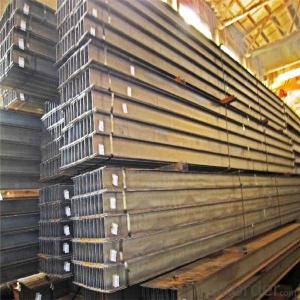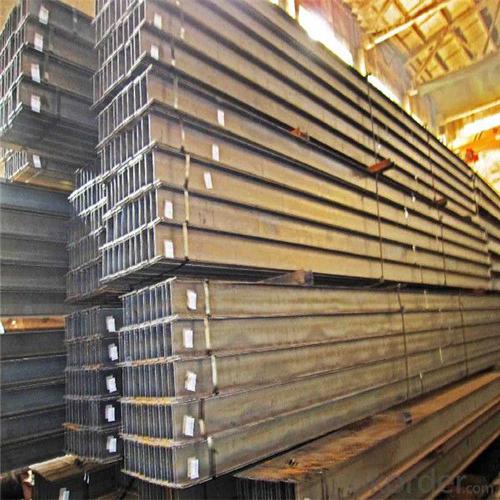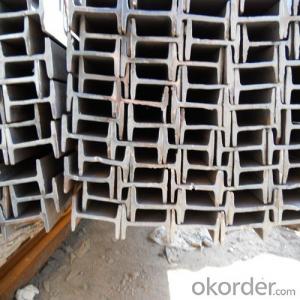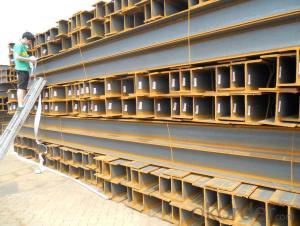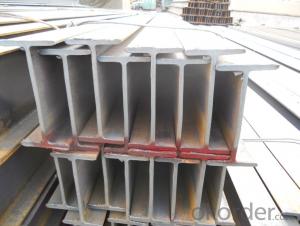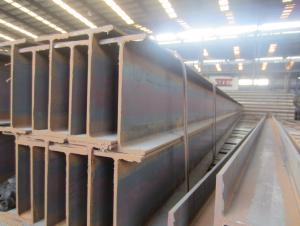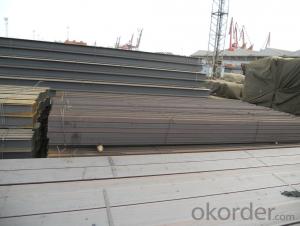GB Structural H Steel Beams Price per Kg
- Loading Port:
- Dalian
- Payment Terms:
- TT OR LC
- Min Order Qty:
- 155 m.t
- Supply Capability:
- 150000 m.t/month
OKorder Service Pledge
OKorder Financial Service
You Might Also Like
Specification
Quick Detail
Place of Origin: | Jiangsu, China (Mainland) | Grade: | SS400, SS400,ST37-2, A36, S235JR, Q235 | Technique: | Hot Rolled |
Thickness: | 8mm | Application: | construction | Length: | 6m-16m |
Standard: | JIS, ASTM,BS,EN | Flange Width: | 50-34mm | Flange Thickness: | 7-34mm |
Web Width: | 100-900mm | Web Thickness: | 5-30mm | Brand Name: | JZZHD |
Model Number: | 350mm*175mm*7mm*11mm | Name: | Steel h beam structure material/ construction steel | Certificate: | SGS,ISO,CE,TUV |
We can provide qualify goods,competitive price and speedy delivery.
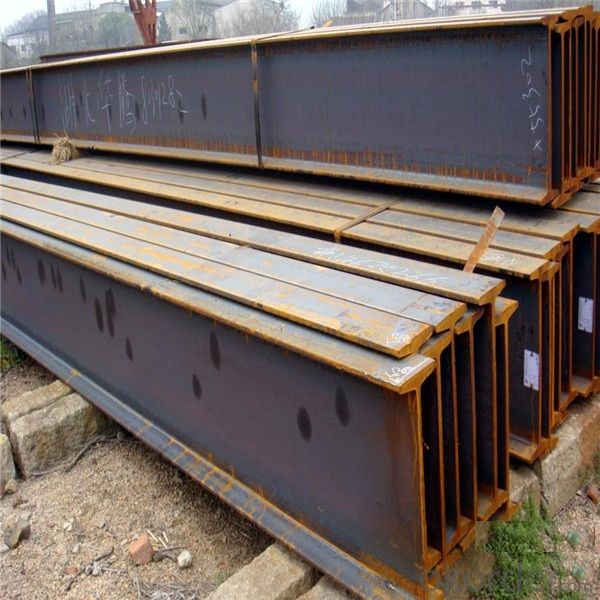
Products Description
Description | High Frenquency Thin-walled H Beam | |
Product Name | H Beam | |
Specification | Height:75-500mm Width:50-250mm | |
Standard | GB700-1998,GB/T1591-1994 | |
Material | Q235B,Q345B | |
Application | a. Bridge and post structures in industry and civil use of steel construction. | |
Certificates | ISO,SGS,BV,TUV,Lloyd | |
MOQ | 20 tons or according to customers’ requirement. | |
Port of Delivery | Tianjin Port of China | |
Remarks | We can provide qualify goods,competitive price and speedy delivery |
Packaging & Delivery
Packaging Details: | Packed with waterproof paper and steel banding. |
Delivery Detail: | 15-25 |
FAQ
1. How can I get some samples?
We are honored to offer you samples. New clients are expected to pay for the courier cost. The samples are free for you.
2 Do you have any certificates?
Our products passed inspection of SGS, FDA, and CE Quality is priority! Every worker keeps the QC from the very beginning to the very end, Quality control department especially responsible for quality checking in each process.
3 Can your factory print or emboss my logo on the goods?
Yes, we can print or emboss the logo on the goods or their packing box.
4 What information should I let you know if I want to get a quotation?
1) The specification of products (length x width x thickness);
2) The temper and alloy.
3) The final product you will use to be made
4 It will be better if you can show us the pictures or design sketch. Samples will be best for clarifying. If not, we will recommend relevant products with details for reference.We usually produce goods based on customers
Samples or based on customers’ picture, logo, sizes etc.
- Q: What are the different methods of lifting and installing steel H-beams?
- There are several methods of lifting and installing steel H-beams, depending on the specific requirements of the project and the available equipment. Some of the common methods include: 1. Crane: The most common and widely used method is using a crane to lift and install H-beams. Cranes come in various sizes and capacities, allowing for efficient and precise placement of beams at the desired location. Depending on the size and weight of the H-beam, different types of cranes such as mobile cranes or tower cranes may be used. 2. Forklift or telehandler: For smaller and lighter H-beams, a forklift or telehandler may be utilized. These machines have forks or lifting attachments that can be adjusted to fit the width of the beam. They provide a versatile and cost-effective solution for lifting and installing beams in tight spaces or on uneven terrain. 3. Hydraulic jacking system: In situations where there is limited access or overhead clearance, a hydraulic jacking system can be employed. This method involves lifting the beam incrementally using hydraulic jacks and inserting shims or temporary supports until the desired height is reached. The process is repeated until the beam is properly installed. 4. Skidding or rolling: This method is suitable for long H-beams or when a crane is not available. It involves using rollers or skids to gradually move the beam horizontally into position. This method requires careful planning and precise coordination to ensure the beam is aligned properly during the installation process. 5. Welding or bolting: Once the H-beams are lifted and in position, they need to be secured to the supporting structure. This can be achieved through welding or bolting, depending on the structural requirements and design specifications. Welding is a permanent method that provides a strong connection, while bolting allows for easy disassembly if required. It is important to note that proper safety measures should be followed during the lifting and installation of steel H-beams. This includes ensuring the equipment is in good working condition, using appropriate slings, chains, or lifting devices, and adhering to relevant safety guidelines and regulations. Additionally, the specific method chosen will depend on factors such as the size and weight of the H-beams, site conditions, and project constraints.
- Q: Can steel H-beams be used in warehouse or distribution center construction?
- Warehouse or distribution center construction can indeed utilize steel H-beams. These H-beams are frequently employed as support elements in sizable structures because of their remarkable strength and capacity to bear heavy loads. They offer exceptional structural stability, making them ideal for warehouses and distribution centers that require ample open spaces and lofty ceilings to accommodate storage and logistics operations. Moreover, steel H-beams boast versatile designs that allow for flexible architectural layouts and the creation of wide-span structures without the need for additional columns or supports. This maximizes the usable space within the facility. Ultimately, the durability, strength, and design flexibility of steel H-beams make them a favored option in warehouse and distribution center construction.
- Q: How to declare the processed H steel? What is the rate of tax refund? Urgent urgent
- H steel customs matters if you want to share, HS, 72161010 section height is less than 80mmH steel (except for thermal processing without further processing) / HS, 72163311 section height of >800mmH steel (except for thermal processing without further processing) / HS, 200mm < 72163319 section height is less than or equal to 800mmH steel (except the heat the processing without further processing) your steel belongs to which HS will you choose!! The tax rebate rates for the 3 HS are 0.
- Q: What is the maximum allowable camber for steel H-beams?
- The maximum allowable camber for steel H-beams is typically specified by the relevant industry standards or project specifications. The specific maximum allowable camber can vary depending on the size, grade, and intended use of the H-beam. It is important to consult these standards or specifications to determine the maximum allowable camber for a specific steel H-beam.
- Q: What are the considerations when designing for thermal bridging in Steel H-Beams?
- When designing for thermal bridging in Steel H-Beams, there are several important considerations to keep in mind. Firstly, it is crucial to consider the thermal conductivity of the steel material itself, as it can significantly impact heat transfer through the beams. Secondly, the design should account for the potential for thermal bridging at connections or joints, where heat can easily transfer between the beams and the surrounding components. Insulation materials or thermal breaks can be implemented at these points to minimize heat loss. Additionally, the overall design should aim to minimize the surface area of the beams that is exposed to the exterior environment, as this can reduce the potential for heat transfer. Proper insulation and thermal analysis should be performed to ensure that the H-Beams meet the required thermal performance standards and minimize energy loss.
- Q: Can steel H-beams be used for agricultural structures?
- Yes, steel H-beams can be used for agricultural structures. Steel H-beams offer several advantages for agricultural buildings. Firstly, they are incredibly strong and durable, able to withstand heavy loads and harsh weather conditions. This makes them ideal for supporting the weight of roofs, walls, and other structural components in agricultural buildings. Additionally, steel H-beams are versatile and can be easily customized to suit the specific requirements of agricultural structures. They can be cut to different sizes and lengths, allowing for flexibility in design and construction. This flexibility also makes them suitable for various types of agricultural buildings, such as barns, storage facilities, and livestock shelters. Moreover, steel H-beams are resistant to pests, rot, and decay, which can be common issues in agricultural environments. This ensures the longevity and reliability of the structures, minimizing the need for frequent repairs or replacements. Furthermore, steel H-beams are fire-resistant, offering an added layer of safety for agricultural buildings. This can be particularly important in areas where fire hazards are a concern. Finally, steel H-beams are cost-effective in the long run. Although they may have a higher upfront cost compared to other building materials, their durability and low maintenance requirements make them a cost-efficient choice over time. Overall, steel H-beams are a suitable and practical option for agricultural structures due to their strength, versatility, durability, resistance to pests and fire, and cost-effectiveness.
- Q: Are steel H-beams suitable for use in the construction of hospitality resorts or hotels?
- Indeed, steel H-beams prove to be a fitting choice for the construction of hospitality resorts or hotels. They possess various advantages that render them the preferred option within the hospitality industry. First and foremost, steel H-beams exhibit remarkable strength and durability, enabling them to bear heavy loads and provide structural stability. This quality proves to be crucial for extensive construction endeavors like hospitality resorts or hotels, which often necessitate multiple floors, expansive areas, and the ability to withstand potential natural disasters such as earthquakes or hurricanes. Furthermore, steel H-beams possess a lightweight nature when compared to other construction materials such as concrete or timber. This characteristic facilitates easier transportation and handling during the construction process. Consequently, this leads to cost savings and accelerated construction timelines, both of which are vital factors in delivering hospitality projects punctually and within budget. Additionally, steel H-beams grant architects and engineers design flexibility, empowering them to create innovative and aesthetically pleasing structures. They can be utilized to craft grand, open atriums, spacious ballrooms, and other distinctive architectural features commonly found in hospitality resorts or hotels. Another notable advantage of steel H-beams is their resistance to fire, pests, and rot. This ensures the long-lasting durability and safety of the structure, thereby reducing maintenance and repair costs over time. Lastly, steel H-beams exhibit environmental friendliness as they are typically fashioned from recycled materials and can be recycled once again at the conclusion of their life cycle. This aligns with the growing trend of sustainable and eco-friendly construction practices within the hospitality industry. To conclude, steel H-beams prove to be highly suitable for the construction of hospitality resorts or hotels due to their strength, durability, design flexibility, fire resistance, and environmental benefits. They provide a reliable and efficient solution for constructing large-scale projects within the hospitality sector, thereby ensuring the safety, comfort, and satisfaction of guests.
- Q: Can steel H-beams be used for warehouse construction?
- Yes, steel H-beams can be used for warehouse construction. Steel H-beams are commonly used in the construction industry due to their strength, durability, and ability to support heavy loads. They provide a cost-effective and efficient solution for warehouse construction, allowing for large open spaces and efficient use of space.
- Q: Can steel H-beams be used in shopping mall construction?
- Shopping malls can indeed utilize steel H-beams. The construction industry frequently employs steel H-beams due to their robustness, endurance, and adaptability. These beams are specifically engineered to endure heavy loads and provide structural reinforcement, which renders them highly suitable for extensive undertakings like shopping malls. The utilization of H-beams in shopping mall construction can encompass an array of purposes, such as bolstering the roof and floors, constructing structural frameworks, and fortifying the overall stability of the edifice. Furthermore, steel H-beams confer various benefits, including their capacity to span significant distances devoid of supplementary support columns, their ability to withstand fire and corrosion, and their recyclability, thus making them an ecologically responsible choice for construction ventures.
- Q: How do steel H-beams compare to concrete beams in terms of cost and durability?
- Steel H-beams and concrete beams have distinct differences in terms of cost and durability. In terms of cost, steel H-beams are generally more affordable compared to concrete beams. Steel is a readily available material and the manufacturing process for H-beams is efficient, resulting in lower production costs. Additionally, steel H-beams can be fabricated off-site and delivered to the construction site, reducing labor costs and construction time. On the other hand, concrete beams require on-site casting, which can be a time-consuming process, and the materials involved in concrete beam construction can be more expensive. When it comes to durability, both steel H-beams and concrete beams have their strengths. Steel is known for its high tensile strength, allowing it to withstand heavy loads and resist bending or warping. This makes steel H-beams a popular choice for structures that require long spans or have large load-bearing requirements. Concrete, on the other hand, has excellent compressive strength, making it suitable for withstanding vertical loads. Concrete beams also have the advantage of being fire-resistant, which is an important consideration in certain applications. However, it is worth noting that steel is susceptible to corrosion if not properly protected. Without appropriate coatings or maintenance, steel H-beams can rust and deteriorate over time, reducing their durability. In contrast, concrete beams have a longer lifespan and are less prone to corrosion. Once properly cured, concrete beams can withstand environmental factors and have a longer service life compared to steel. In summary, steel H-beams offer cost advantages due to their affordability and ease of fabrication, while concrete beams are generally more durable with a longer lifespan. The choice between the two materials ultimately depends on the specific requirements of the project, including load capacities, span lengths, and environmental factors.
Send your message to us
GB Structural H Steel Beams Price per Kg
- Loading Port:
- Dalian
- Payment Terms:
- TT OR LC
- Min Order Qty:
- 155 m.t
- Supply Capability:
- 150000 m.t/month
OKorder Service Pledge
OKorder Financial Service
Similar products
Hot products
Hot Searches
Related keywords
